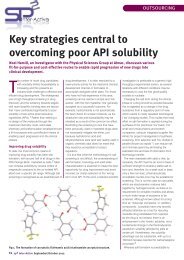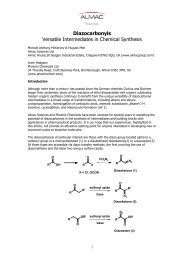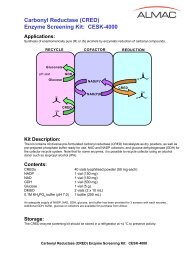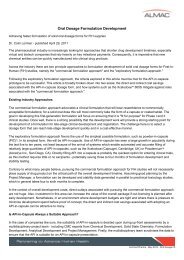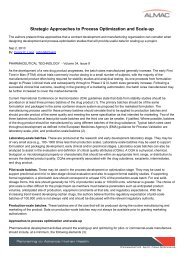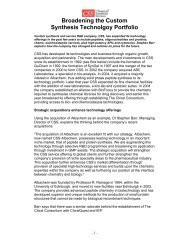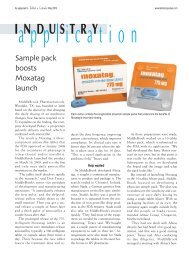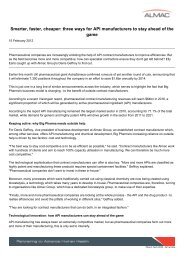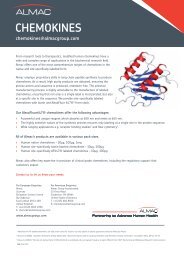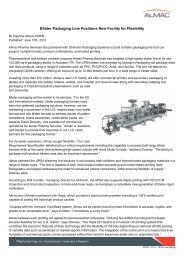Fluorescent PET (Photoinduced Electron Transfer) sensors ... - Almac
Fluorescent PET (Photoinduced Electron Transfer) sensors ... - Almac
Fluorescent PET (Photoinduced Electron Transfer) sensors ... - Almac
You also want an ePaper? Increase the reach of your titles
YUMPU automatically turns print PDFs into web optimized ePapers that Google loves.
Fig. 4 De-excitation pathways open to the photo-excited fluorescent <strong>PET</strong> sensor 1.<br />
Another more recent example shows how these thermodynamic<br />
arguments help even when fluorescent <strong>PET</strong> <strong>sensors</strong> are<br />
constructed without a covalent linkage between the fluorophore<br />
and the receptor. Self-assembly of the trianionic fluorophore 2<br />
within the cavity of the tetracationic receptor 3 produces the ‘off’<br />
state of the sensor system. 18 The reduction potential of the<br />
receptor can be estimated from that of dimethyl viologen<br />
( 0.3 V). 17 The oxidation potential of 2 is 0.8 V and its excited<br />
state energy is 3.0 eV (Fig. 5b). 19 Fast <strong>PET</strong> is made possible by<br />
significantly negative DG <strong>PET</strong> value ( 1.9 eV). Displacement of 2<br />
from its complex with 3 by guanosine triphosphate (GTP) occurs<br />
due to increased synergistic effects, such as electrostatics and<br />
p-stacking inside the cavity. Since the fluorophore 2 is now<br />
distanced from the receptor 3 (besides somewhat less favourable<br />
thermodynamics for <strong>PET</strong>) fluorescence is switched ‘on’. Sensing<br />
of GTP is thus enabled.<br />
The validity of such molecular engineering makes <strong>PET</strong><br />
<strong>sensors</strong> 20 an important segment of research in molecular<br />
devices. 21<br />
Early history<br />
The first case fitting the above description of a fluorescent <strong>PET</strong><br />
sensor was Wang and Morawetz’s dibenzylamine compound<br />
(4; as seen later in Fig. 7b). 22 It contained a small fluorophore<br />
requiring excitation in the deep ultraviolet, spaced with a methylene<br />
group from an aliphatic amine receptor. Naturally, H + was<br />
the chosen target, though it was also engaged with Zn 2+ and also<br />
reacted with acetic anhydride. Several cases 23–28 followed with<br />
Fig. 5 The relative energetic dispositions of the frontier orbitals of the<br />
fluorophore and the receptor in the analyte-free situation for <strong>PET</strong> sensor<br />
systems (a) 1 and (b) 2$3. Redox potentials (V vs. sce) are given in<br />
parentheses as a measure of molecular orbital energies. The energies are<br />
not to scale.<br />
spacers ranging from trimethylene to none at all. The latter<br />
situation occurred due to the sterically-enforced twisting of an<br />
aniline receptor from an anthracene fluorophore. The generality<br />
of the sensing principle was established with a set of related<br />
cases 28–36 carrying different fluorophores (or phosphors), spacers<br />
and receptors. Reviews of this phase are available. 4,5,37,38<br />
Current uptake<br />
As may be expected, a principle that is general, flexible and<br />
extensible tends to be put to use by people seeking solutions to<br />
various analytical problems. A sensing principle would naturally<br />
be applied to target various analytes in various situations. A<br />
commercially successful example which measures blood<br />
components like H + , Na + , K + and Ca 2+ deserves a special<br />
mention. 39 There is a growing body of work where <strong>PET</strong> <strong>sensors</strong><br />
are operating within living cells. 40,41 The current situation is<br />
perhaps best shown graphically. Fig. 6a and 6b show the sources<br />
for fluorescent <strong>PET</strong> <strong>sensors</strong> and switches around the world as<br />
deduced from the literature. Some of these laboratories may have<br />
produced a single publication in this field or several dozen. It is<br />
clear that research in fluorescent <strong>PET</strong> <strong>sensors</strong> is now a delocalized<br />
activity.<br />
A case study: dipicolylamine-based <strong>sensors</strong><br />
It is educational to track how a single avenue of fluorescent <strong>PET</strong><br />
<strong>sensors</strong> has evolved. It illustrates how different people considering<br />
different problems can exploit a single structural motif.<br />
Consider di(2-picolyl)amine {IUPAC name: 2-pyridinemethanamine,<br />
N-(2-pyridinylmethyl)-} which is a popular receptor 42 for<br />
d-block cations among coordination chemists. All of the structures<br />
discussed are contained within Fig. 7a and 7b.<br />
Though 5 (Fig. 7a) was a previously known compound, 43<br />
S. A. de Silva et al. 44 were the first to recognize its ‘fluorophore–<br />
spacer–receptor’ format, its <strong>PET</strong> potential and its di(2-picolyl)-<br />
amine receptor 42 for Zn 2+ . Indeed a strong Zn 2+ -induced<br />
switching ‘on’ of fluorescence (fluorescence enhancement factor,<br />
FE ¼ 77) is seen in acetonitrile. No wavelength shift of the<br />
emission band is seen as befits a <strong>PET</strong> system. The replacement of<br />
the terminal methyl groups of 1 by 2-pyridyl units will make the<br />
DG <strong>PET</strong> only slightly more positive. The thermodynamic conditions<br />
for cation sensing discussed in a previous paragraph are<br />
maintained. More recent crystallographic and computational<br />
studies have also backed up the Zn 2+ -binding of 5. 45<br />
The modularity of the <strong>PET</strong> sensing system 5 can now be<br />
exploited in many ways and we track structural mutations where<br />
the dipicolylamine unit is conserved. The number of laboratories<br />
that have followed this path is remarkable, spurred on by the<br />
This journal is ª The Royal Society of Chemistry 2009 Analyst, 2009, 134, 2385–2393 | 2387





